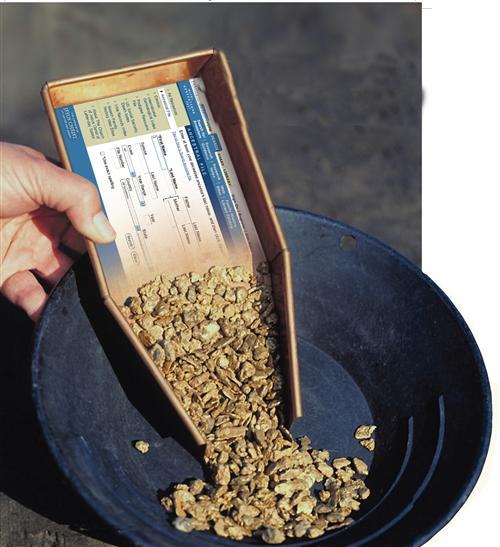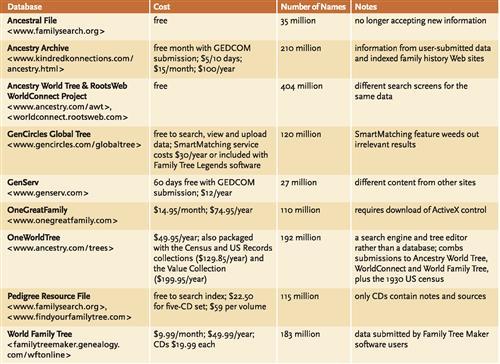Sign up for the Family Tree Newsletter Plus, you’ll receive our 10 Essential Genealogy Research Forms PDF as a special thank you!
Get Your Free Genealogy Forms
"*" indicates required fields
If you’ve read this magazine for any time at all, you’ve probably absorbed numerous warnings about the risks of misinformation in the shared family trees found in online pedigree databases. These collections of GEDCOM files—the universal genealogy computer format—seem to let you download whole branches of your family tree, with somebody else doing the research for you. But as we frequently caution, the sad truth is that no one officially verifies any of these ancestries: It’s not the responsibility of database webmasters, and there’s no telling whether the submitters have bothered to look into their data. An online pedigree file may connect the dots for your family history all the way back to the 10th century—but without proof, you might as well just make it up yourself. In a genealogical court of law, in other words, online pedigree files wouldn’t be admissible.
So why bother with these databases—such as Ancestral File and the Pedigree Resource File on Family Search <www.familysearch.org> and RootsWeb’s World Connect Project <www.ancestry.com/awt>). Even GenCircles’ Global Tree <genforum.com> (you can mine message boards at GenForum and Ancestry.com/RootsWeb <boards.ancestry.com> for clues much as you can pedigree files). So I used the e-mail address posted at the top of Jerry’s WorldConnect page to drop him a line, explaining how my family tree intersected with his and offering to exchange information. Jerry kindly wrote me back, and we figured out we were third cousins twice removed—his grandfather and my great-great-grandmother were first cousins. After a few e-mails, Jerry sent me a transcription from a small cemetery where my fourth-great-gtandmother was buried, information I didn’t have.
4. Seek out sources.
The answers to your ancestral riddles may lurk in some place you never thought to search—but the submitter of an online pedigree file did. Many pedigree databases allow for sources, namely GenCircles, Ancestry World Tree/WorldConnect, World Family Tree and OneGreatFamily (double-click an individual and then click on the Citations icon). GenServ has a single field for both sources and notes; click on the icon that looks like paper-clipped pages. To view the sources for a Pedigree Resource File submission, you’ll need to buy the corresponding CD (order it from 800-537-5971 or <www.ldscatalog.com>); the online file’s Sources field will tell you which disc you need. World Family Tree has spaces for sources and notes, but they’re seldom filled in.
In fact, few uploaded family trees include source information—citations appear only if submitters included and uploaded them with their files. You can limit your searches to entries with sources at GenCircles and (using the advanced search) at WorldConnect; Ancestry World Tree’s search results indicate with a book icon which pedigrees have source information.
A GenCircles listing for George H. Clough, for example, mentions “Murphy-Sedgwick Memorial Home, Canton, Illinois, Volume I — July 14,1885 — December 31,1917” as one source. If this George H. Clough were one of your ancestors (alas, it turns out he’s not one of mine), you could follow up and track down this funeral-home record. The same entry cites the 1890 city directory for Alton, Ill., as a source with a note, “lists George Clough, a miner, living on Elm St. in North Alton, Illinois.” Again, you could go check out that city directory for yourself.
When scouting for sources, it’s worth looking at pedigree files even for people who aren’t in your direct line. The sources someone else used to learn about your ancestor’s sibling or cousin might well contain clues you can use, too.
Don’t, however, confuse real sources with those all too commonly “cited” in uploaded family tree files: other pedigree databases. “WFT” is a frequent reference in shared GEDCOMs, but other than suggesting you might want to check World Family Tree for actual clues, this is useless.
5. Take note of notes.
In addition to files that include sources, check for ones with notes attached. The databases that accommodate notes are generally the same as those with sources (GenServ combines them). Again, to view the notes for Pedigree Resource File entries, you’ll have to buy the appropriate CD. You can restrict your search to entries with notes on GenCircles and WorldConnect’s advanced search.
Substantive notes in pedigree databases can be even more rare than sources. When you do come across them, though, you may strike real gold. Truly helpful submitters sometimes include not only a bare-bones source citation, but also a transcription of the actual record. You’ll eventually want to verify this transcription yourself by hunting down the original source. In the meantime, however, such a treasure can really jump-start your research.
I’ve found census transcriptions, obituaries, deed abstracts and even complete wills in the notes of online pedigree files. When poking around in pedigrees for my Oglesby-Bradley ancestors, for instance, I found a summary of legislative petitions mentioning Thomas Oglesby; a quotation from a book, Men of Mark of Virginia(complete with page number, so I can later look it up at the library); 1820 and 1830 census extracts; Georgia land lottery records; and — the real prize — the complete transcribed 1799 will of William Bradley, my sixth-great-grandfather.
Good as Gold
How can you make sure the GEDCOM files you upload to a pedigree database contain genealogical gold-instead of adding to the online garbage heap? Good GEDCOMs start, of course, with solid research. Make sure each fact in your file is tied to a source citation (and, no, other pedigree databases do not qualify as sources!). Use your genealogy software’s Notes field liberally Feel free to include transcriptions, properly cited, of the original records you’ve used. (For books and newspaper articles published after 1923, avoid copyright infringement by including only abstracts.) In short, do unto other researchers as you wish they’d do unto you.
One more hint: When you export your GEDCOM file from your genealogy software, make sure that your sources, notes and other goodies are all included. You may have to check some boxes to export everything.
Finally, be sure to exercise your software’s option to omit or make anonymous any living individuals in your file. In these privacy-wary days, if s a matter of courtesy and security.
Pedigree Prospecting
Today’s mega-databases of family tree files sprang up as a way for researchers to swap and share their genealogies. Although there’s a lot of overlap, these tools contain information on more than a billion ancestors submitted by your fellow family historians. Here’s the dirt on the nine biggest collections.
Sure enough, the pedigree files I found suggested the existence of an Abraham Stowe who was born in Virginia in 1762, lived in Lincoln County, NC, and died in 1841. This Abraham (No. 1) would’ve been 78 in the 1840 census, in which I’d found a slightly older Abraham Stowe, age 80 to 90. That senior Abraham—whom the pedigree files helped me realize was likely a different individual (No. 2)—was in Surry County, NC, not Lincoln County, in 1840. And the marriage record that started me on this whole chase was from—you guessed it—Surry County. With this evidence, I could pursue the proof that Abraham No. 2 is indeed my man, without the confusion of data about Abraham No. 1.
Striking the Errors
What can you do when you spot an error in an online pedigree database? The Web site says your great-grandmother was born in 1870, but now you have proof she was born in 1863.
If you’re the one who submitted the file in the first place, the solution is simple—usually. GenCircles, for example, lets you update your uploads or delete the whole tree, as do Ancestry World Tree, WorldConnect and CenServ. Ancestry Archive, One Great Family and Ancestry.com’s One World Tree incorporate an online tree editor, so the ability to fix or update your info is built right in. You can submit updates to World Family Tree, but of course you can’t fix information that’s already gone out on its zillions of CDs. Pedigree Resource File lets you resubmit an entire file, but both the new file and the old one will remain “live.” Ancestral File is closed, so your only recourse there is a new Pedigree Resource File submission.
When the error is in another person’s file, some databases—including Ancestry World Tree and WorldConnect—let you add a “sticky note” online. Otherwise, your only recourse may be to try to contact the submitter (see tip 3) and make your case. (Remember, though, you can’t force a researcher to change his data—even though the facts relate to your family, you don’t own the information. Names, dates and places are part of public record.) Of course, you can always go ahead and upload your own, correct pedigree file and hope the truth will prevail.
That’s the ultimate point of connecting with distant kin, after all—not just to exchange unsubstantiated guesses about your common ancestry, but to share real research you’ve done. Many researchers you’ll find via pedigree files still live close to your shared family branch’s ancestral home, where they’ve been able to do in-person records research.
Not all pedigree databases make it easy to follow up with submitters, however. WorldConnect and its mirror version, Ancestry World Tree, both put the submitter’s e-mail in gray, slanted letters as a small image, so you can read it but spammers trolling the Internet for addresses cannot. Ancestry.com’s OneWorldTree, a paid-access search engine that “stitches” together related data from several pedigree sites, has a Contact Ancestry Members Interested In This Person button that takes you to a page where you can choose submitters to anonymously e-mail.
GenCircles lets you view not only a spam-safe e-mail address, but also a short profile of the submitter, including a list of other files she’s uploaded. Ancestral File provides submitters’ mailing addresses (click on the Details link toward the lower right corner of the page), as does the Pedigree Resource File. (In Pedigree Resource File, you can click on the long number after Submission Search to bring up a search screen with the submitter’s identification number already filled in. Narrow this search further if you like, and then click the Search button to see what else this person has shared.)
You can see the submitter’s e-mail address and phone number on Ancestry Aicbive <www.kindredkonnections.com/ancestry.html>. The subscription database OneGreatFamily <www.onegreatfamily.com>, though really designed to agglomerate data into one giant shared family tree, does have a way to contact fellow researchers if you dig deep enough: Double-click on an ancestor you’re interested in, then hit the Collaborate button at the lower left of the box that opens; under the Owners tab, you can then click on a name to see an e-mail address and send a message to that submitter. At GenServ <www.genserv.com>, only subscribers can get submitter details (not trial-access users). And Genealogy.com’s World Family Tree <familytreemaker.genealogy.com/wftonlino>, an online subscription (also available on CD) created from files submitted by Family Tree Maker <www.familytreemaker.com> software users, requires you to go through a cumbersome Contributor Contact Information Service to hook up with submitters.
From the February 2006 issue of Family Tree Magazine.
ADVERTISEMENT






